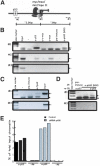The p400 E1A-associated protein is a novel component of the p53 --> p21 senescence pathway
- PMID: 15655109
- PMCID: PMC545875
- DOI: 10.1101/gad.1280205
The p400 E1A-associated protein is a novel component of the p53 --> p21 senescence pathway
Abstract
Adenovirus E1A-associated p400 belongs to the SWI2/SNF2 family of chromatin remodeling proteins. Here, we report that p400 is a component of the p53-p21(WAF1/CIP1/sid1) pathway, regulating the p21 transcription and senescence induction program. Acute depletion of p400 expression by shRNA (short hairpin RNA) synthesis led to premature senescence of untransformed human fibroblasts, whose features include G1 arrest, p21 induction, senescence-associated heterochromatic foci (SAHF), and beta-gal staining. Importantly, p400shRNA-induced premature senescence phenotypes were rescued by coexpression of p53-shRNA or p21-shRNA. Furthermore, p400 complex colocalized with p53 on the p21 promoter. These data suggest that the p400 complex inhibits p53 --> p21 transcription and the development of premature senescence.
Figures





References
-
- Brown J.P., Wei, W., and Sedivy, J.M. 1997. Bypass of senescence after disruption of p21CIP1/WAF1 gene in normal diploid human fibroblasts. Science 277: 831–834. - PubMed
-
- Cai Y., Jin, J., Tomomori-Sato, C., Sato, S., Sorokina, I., Parmely, T.J., Conaway, R.C., and Conaway, J.W. 2003. Identification of new subunits of the multiprotein mammalian TRRAP/TIP60-containing histone acetyltransferase complex. J. Biol. Chem. 278: 42733–42736. - PubMed
-
- Deleu L., Shellard, S., Alevizopoulos, K., Amati, B., and Land, H. 2001. Recruitment of TRRAP required for oncogenic transformation by E1A. Oncogene 20: 8270–8275. - PubMed
-
- el-Deiry W.S., Tokino, T., Velculescu, V.E., Levy, D.B., Parsons, R., Trent, J.M., Lin, D., Mercer, W.E., Kinzler, K.W., and Vogelstein, B. 1993. WAF1, a potential mediator of p53 tumor suppression. Cell 75: 817–825. - PubMed
Publication types
MeSH terms
Substances
Grants and funding
LinkOut - more resources
Full Text Sources
Other Literature Sources
Molecular Biology Databases
Research Materials
Miscellaneous
